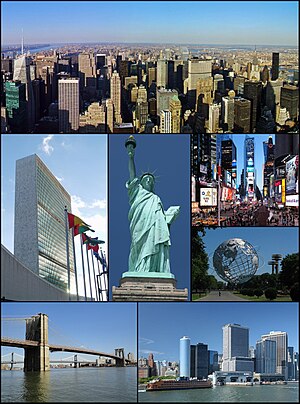"New York, New York" and "NYC" redirect here. For other uses, see New York, New York
This article is about the city. For other uses, see New York City (disambiguation).
New York is the most populous city in the United States and the center of the New York metropolitan area, which is one of the most populous metropolitan areas in the world. New York City has a significant impact on global commerce, finance, media, culture, art, fashion, research, education, and entertainment. As host of the United Nations Headquarters, it is also an important center for international affairs. The city is often referred to as New York City or the City of New York to distinguish it from the state of New York, of which it is a part. Located on a large natural harbor on the Atlantic coast of the Northeastern United States, the city consists of five boroughs: The Bronx, Brooklyn, Manhattan, Queens, and Staten Island. The city's 2009 estimated population approached 8.4 million, and with a land area of 305 square miles (790 km2),[3][4][5] New York City is the most densely populated major city in the United States The New York metropolitan area's population is the USA's largest, estimated at 19.1 million people over 6,720 square miles (17,400 km2). The Combined Statistical Area contained 22.2 million people as of 2009 Census estimates, also the largest in the United States.
New York was founded as a commercial trading post by the Dutch in 1624. The settlement was called New Amsterdam until 1664 when the colony came under English contro New York served as the capital of the United States from 1785 until 1790.It has been the country's largest city since 1790 As many as 800 languages are spoken in New York City, making it the most linguistically diverse city in the world.[10]
Many districts and landmarks in the city have become well known to outsiders. The Statue of Liberty greeted millions of immigrants as they came to America in the late 19th and early 20th centuries. Times Square, iconified as "The Crossroads of the World", is the brightly illuminated hub of the Broadway theater district, one of the world's busiest pedestrian intersections, and a major center of the world's entertainment industry. Anchored by Wall Street, in Lower Manhattan, New York vies with London as the financial capital of the world[11][12][13][14][15][16][17] and is home to the New York Stock Exchange, the world's largest stock exchange by market capitalization of its listed companies. The original Manhattan Chinatown attracts throngs of tourists to its bustling sidewalks and retail establishments. World-class schools and universities such as Columbia University and New York University
| City of New York | |||
|---|---|---|---|
| From top left: Midtown Manhattan, the United Nations Headquarters, the Statue of Liberty, Times Square, the Unisphere in Queens, the Brooklyn Bridge, and Lower Manhattan with the Staten Island Ferry | |||
| | |||
| Nickname(s): The Big Apple, Gotham, Center of The Universe, The City That Never Sleeps | |||
| Location in the state of New York | |||
Cityscape A panorama of New York City taken from Hoboken, NJ. Beginning at the George Washington Bridge on the far left to Midtown Manhattan in the middle and the Verrazano-Narrows Bridge at the far right. ArchitectureMain article: Architecture of New York City Further information: List of tallest buildings in New York City New York has architecturally noteworthy buildings in a wide range of styles. These include the Woolworth Building (1913), an early gothic revival skyscraper built with massively scaled gothic detailing. The 1916 Zoning Resolution required setback in new buildings, and restricted towers to a percentage of the lot size, to allow sunlight to reach the streets below. The Art Deco style of the Chrysler Building (1930), with its tapered top and steel spire, reflected the zoning requirements. The building has distinctive ornamentation such as replicas at the corners of the 61st floor of the 1928 Chrysler eagle hood ornaments. A highly influential example of the international style in the United States is the Seagram Building (1957), distinctive for its facade using visible bronze-toned I-beams to evoke the building's structure. The Condé Nast Building (2000) is an prominent example of green design in American skyscrapers New York's large residential districts are often defined by the classic brownstone rowhouses, townhouses, and tenements that were built during a period of rapid growth from 1870 to 1930. Stone and brick became the city's building materials of choice after the construction of wood-frame houses was limited in the aftermath of the Great Fire of 1835 A distinctive feature of many of the city's buildings is the wooden roof-mounted water towers. In the 1800s, the city required their installation on buildings higher than six stories to prevent the need for excessively high water pressures at lower elevations, which could break municipal water pipes. Garden apartments became popular during the 1920s in outlying areas, including Jackson Heights in Queens. New York State ParksThere are seven state parks within the confines of New York City, including Clay Pit Ponds State Park, a natural area which includes extensive riding trails, and Riverbank State Park, a 28-acre (110,000 m2) facility that rises 69 feet (21 m) over the Hudson River.[81]New York City Department of Parks and Recreation
| |||




No comments:
Post a Comment